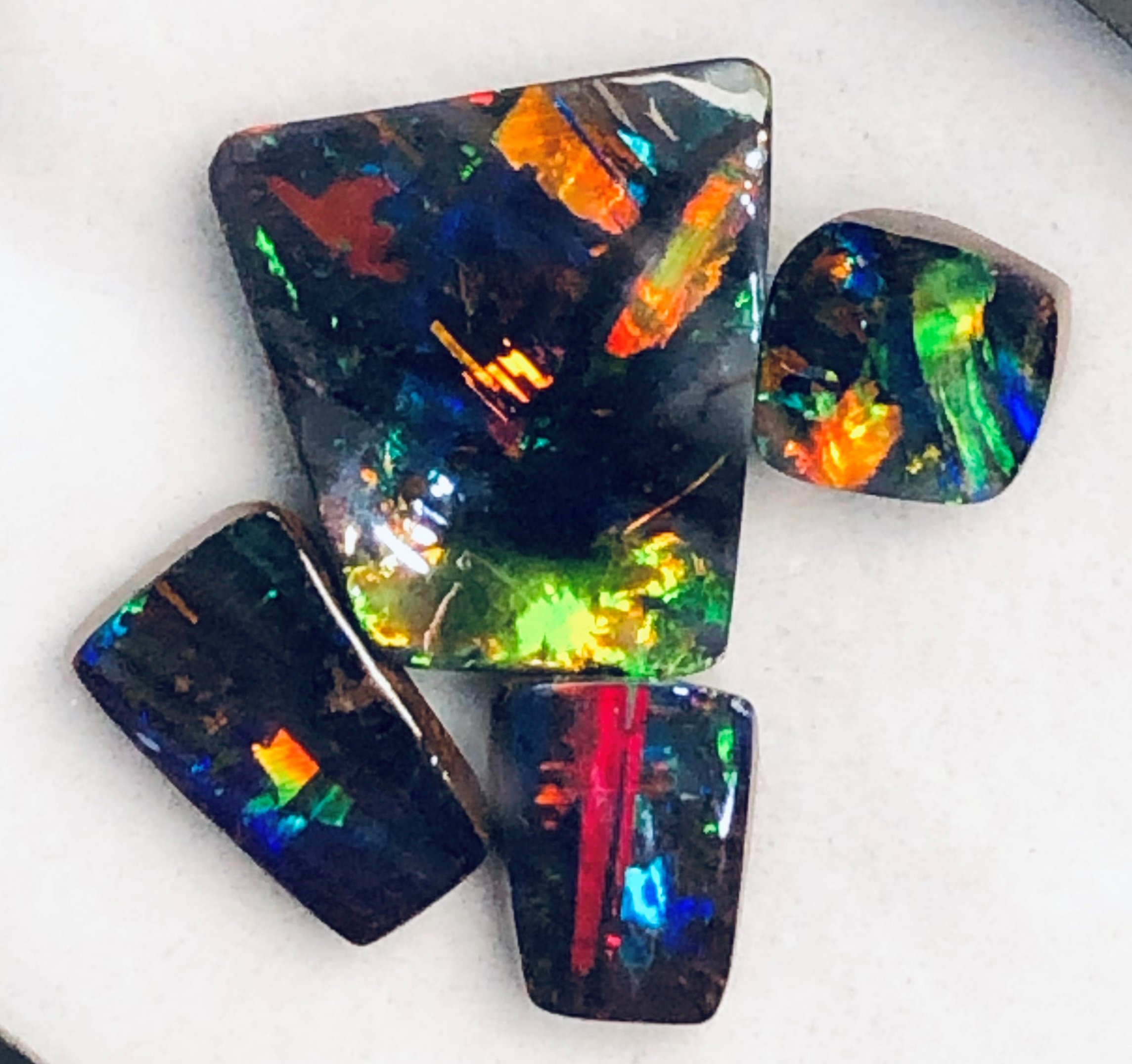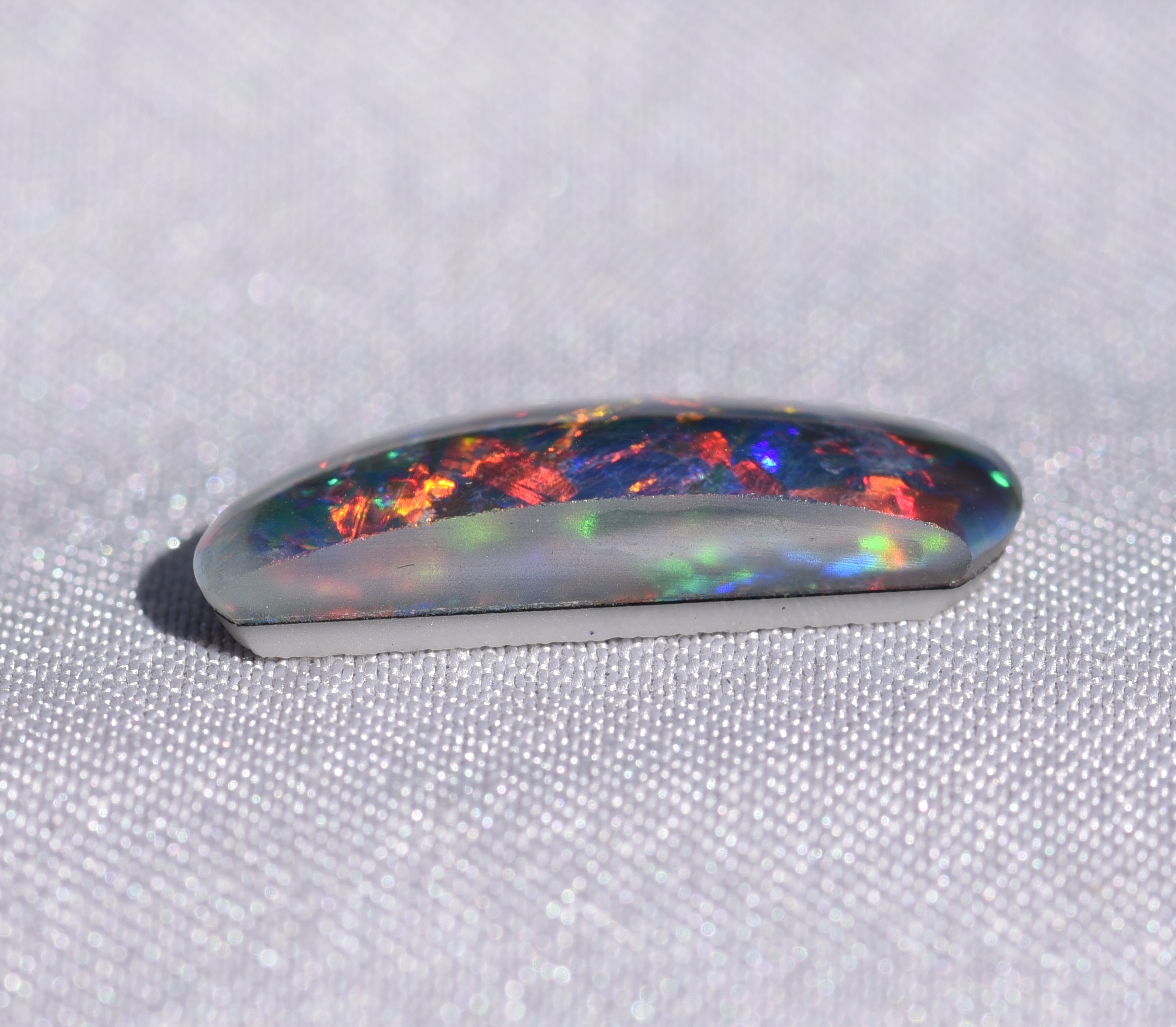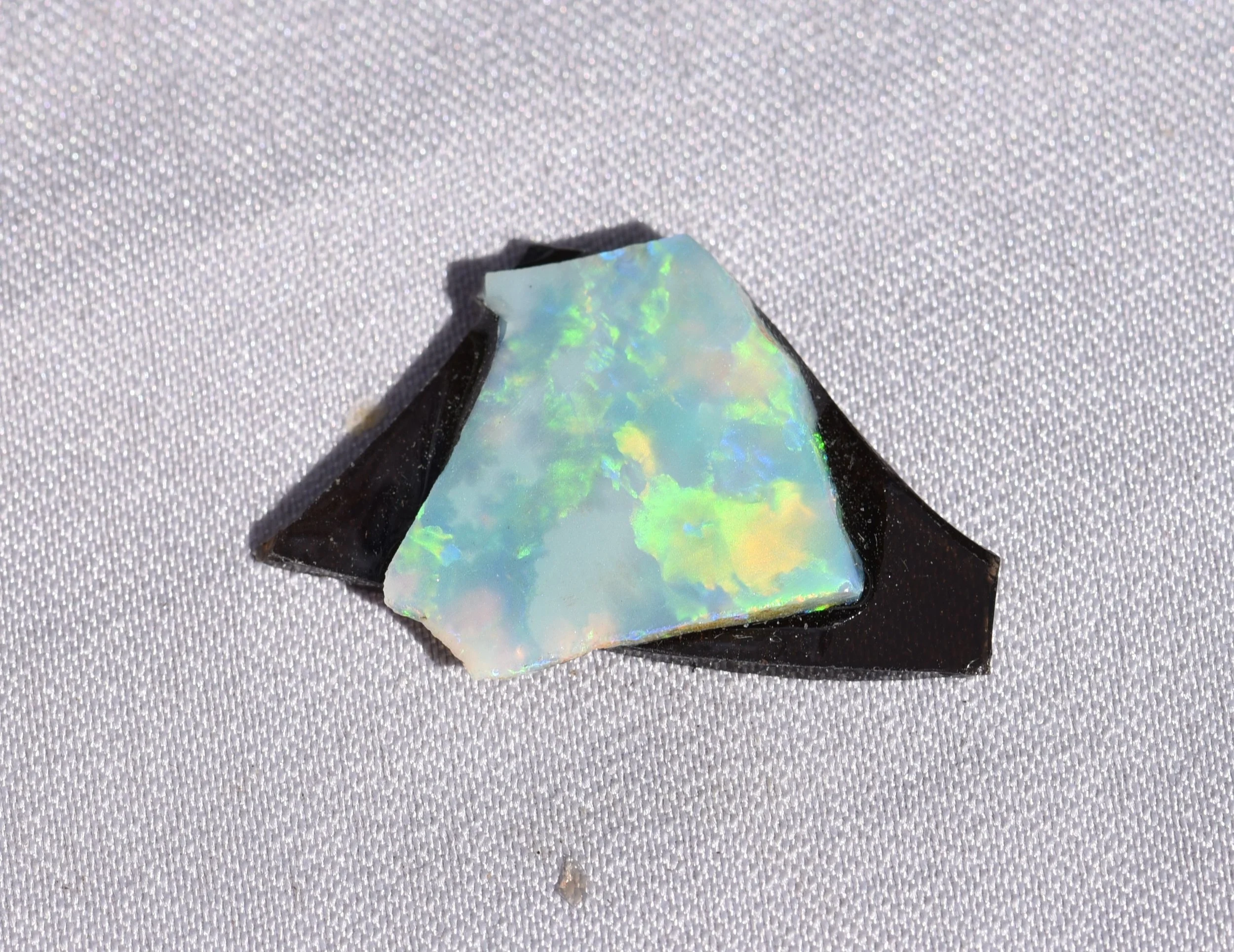What is Black Opal?
What does the term “black opal” mean?
Here is a term used in the opal industry that in many ways is not well understood and in particular by the consumer, or those outside the opal industry. The definition of the term “Black Opal” is published in The Gemmological Association of Australia’s journal, the Australian Gemmologist. It is a definition that at the time of publication was agreed on by all jewellery industry associations at that time. It is a term freely used in literature to describe how “dark” the background is to the play-of-colour seen in precious opal. The definition is:
“Black opal - is the family of opal which shows a play-of-colour (POC) within or on a black body tone when viewed face up……….
You can read about the opal nomenclature in the section of the Opal Academy Library, and you can read the fore mentioned published nomenclature here.
what are the varieties or family of black opal?
There are several varieties of “Black Opal” Originally black opal was a term used primarily in Lightning Ridge as this is where the term originated. In order to incorporate the term Black opal in an overall “opal nomenclature”, the scope of what is considered black opal has been expanded, in a similar fashion to terms used in the description of other gemstones, whilst including well used precious opal terminology.
In this discussion then we have:
Precious black opal: Precious opal (opal with POC) intimately including black potch cut as one piece which is also essentially opaque
Precious black “crystal” opal: Precious opal which is transparent to translucent which has a “black” body colour or tone. Including
Precious black boulder opal; Precious opal that is “opal and rock”, naturally formed.
Precious black matrix opal: naturally occurring precious opal in rock.
Black potch opal and black common opal
Examples are provided below, please also visit the blog posts on individual opal occurrences in the library.
What is the enigma of black opal?
The enigma associated with the term “black opal” arises from the instance that the precious opal is not just black. Precious black opal is an opal gemstone that shows a vibrant (to varying degrees) play-of-colour (POC) of the rainbow colours of the visible spectrum. Black potch opal does not show POC, and if black potch was cut as a plaque or cabochon it would look similar to black onyx.
some examples of black opal and discussion
Authors note: included in the discussion of black opal are some examples of different black opal occurrences. Our list of examples is not yet complete. We need to include some occurrences in the USA and Mexico. Specimens and photographs are being sought after and will be included as they become available, we don’t want to leave anything out. If you have something to add to the discussion, and information please email and contact the academy!
Lighting ridge
A black opal nobby from Lightning Ridge showing black potch along the bottom and right hand side and vibrant green on blue precious black opal above. The white material is the bleached sandstone country rock found in Lightning Ridge. This specimen courtesy of colleagues Vicki Bokros and Down to Earth Opals
A black opal “nobby” showing a violet blue colour bar of precious opal sandwiched between two separate layers of very dark grey potch opal.
An example of a black opal potch nobby from Lightning Ridge NSW, Australia
A vibrant green on blue precious black opal from Lightning Ridge.
Precious black seam opal colour bars between layers of dark (grey) opal potch. Photo courtesy Down to Earth Opals
An exceptional free form opal carving from Lightning Ridge Seam opal
black crystal opal
Black crystal opal is a variety of black precious opal that has a “black or very dark body colour or body tone as described in the opal nomenclature. Black crystal opal is a ‘colloquial’ term used in particular in Australia. The precious opal has a Play-of-colour (POC) that can be very vibrant and is displayed by definition on or within a ‘black’ background. This description is not limited to opal from Lightning Ridge.
Authors Note: we are working on obtaining a few more suitable photographs for this part of our discussion, These will be added when they are available.
A bright red on black .with a hint of green Black Crystal opal with a random and slightly directional pattern. Courtesy Rudy Weber photographic collection
A bright orange green black crystal opal showing a random pattern Courtesy Rudy Weber photographic collection
A bright green/yellow black (borderline dark crystal opal showing broad pattern. Courtesy Rudy Weber photographic collection
queensland black boulder opal
Natural untreated precious black opal comes in a variety of forms. these can be precious black (solid) opal, or opal with a play-of-colour on a natural black potch , precious black boulder opal, precious black matrix opal (untreated), or precious black hydrophane opal (untreated).
A vibrant red multicoloured precious black boulder opal. Specimen courtesy Sherman Opals
A profile view of the Precious black boulder opal shown left, Note the black haematite stained line between the POC and the ironstone/sandstone base.
precious black boulder opal showing a very bright violet (purple) blue POC in a small pattern and with a hint of green! Opal Courtesy Sherman Opals, Photo by A. Smallwood
A Parcel of four exquisite bright multi-coloured precious black boulder opals. opals courtesy True Blue Opals, Photo A. Smallwood
andamooka-south australia
A large opal specimen known as the “Koninderie” exhibiting natural precious black matrix opal
A free-form natural precious black opal from Andamooka SA, the specimen is courtesy of Ivan Forest. Photo by A. Smallwood
mintabie south australia
A vibrant green/blue precious Mintabie black opal showing a random pattern and free form shape. Specimen courtesy Max Novelli, Mintabie Opals Australia.
A red multi-coloured precious black borderline “dark” free form pear shaped cabochon Mintabie opal
ethiopia
A black precious opal specimen from Ethiopia
An Ethiopian black hydrophane opal specimen, the stone on the right has been cut from this specimen
A precious black hydrophane opal cut from the specimen on the left
european opal - slovakia
A black crystal opal from Slovakia in reflected light showing a subdued blue violet Play-of-Colour (POC)
Courtesy Peter Semrad
The Slovakian black opal shown to the left and photographed in transmitted light and showing the nature of the black body colour or body tone.
Courtesy Peter Semrad
A precious black crystal opal showing a bright red/green play-of-colour, and with a slightly dark brownish body colour or body Tone
Courtesy Peter Semrad
honduras
A free form precious black boulder opal from Honduras. The opal is incorporated on a basalt rock base.
Precious black matrix opal from Honduras showing pin-point colour in a basalt matrix.
A view of the precious black matrix opal on the left when examined under the microscope.
indonesia
Precious black (very dark brown) Indonesian opal cabochons
A freeform piece of black (very dark brown) precious crystal opal from Indonesia. This opal has been referred to as “Tea opal”
what makes black opal black?
There has been a long standing discussion amongst opal research scientists as to the question of what makes black opal black. A number of researchers have written scientific papers on this subject,. Most of the discussion revolves around the black opal from Lightning Ridge. As an historical aside, this was a question asked by a student at the Gemmological Association of Australia, whilst the author Anthony (Tony) Smallwood was lecturing. It stimulated Tony’s interest in this research. you can read the results of this research in the Neutron Activation Analysis papers in the literature section of the academy here.
There are two schools of thought in this discussion. Does the black colour occur due to the included trace elements included in the opal, or does the blackness occur due to black organic material included in the opal during its formation. In many ways this is ongoing research which we will publish in the academy as research moves forward. Present thinking being discussed suggests that it may be a combination of the two!
More literature
McOrist, G.D. , Smallwood A.G., Fardy, J.J. (1994) Trace Elements in Australian Opals using Neutron Activation Analysis. JRadio.Nuclear.Chem, Articles V185,2,293-303. Read the article here
Gallacher, A.D. (2001) Geochemistry of sedimentary opal, Hebel, Southern Queensland - PhD Thesis University of Melbourne.
Fink, A.D., (2013) Composition, Structure and Origin of Lightning Ridge Black Opal - PhD Thesis, La Trobe University Melbourne.
let’s discuss the occurence of black opal
Presently , Lightning Ridge in NSW Australia is recognised as an opal mining area which produces the best quality black opal. We will say the Lightning Ridge district includes the older fields closer to the present township as well as the outer lying fields including the Coocoran, Glengarry, Grawin and Sheepyards (we will be developing more information on each of these fields.
Other areas in Australia produce a limited amount of quality black opal, these include, Mintabie, Coober Pedy, Andamooka, in South Australia, historically White Cliffs in NSW. Also in NSW, the mines in Tintenbar, northern NSW has also produced black opal, the geology of this latter field is slightly different.
Overseas, occurrences include Ethiopia, Indonesia, USA, Mexico and Honduras. The reader is directed to the individual pages in the library relating to these occurrences.
How is the term Black opal graded in Gemmology?
The colour patches from the rock colour chart
The cover of the Rock Colour Chart
The original opal nomenclature included reference to a scale of body tone or body colour, a neutral scale from black to white. The scale was originally used by the Lightning Ridge Miners Association’s opal advisory service an institution that still operates to day to give relative valuing information on the opal fields for the opal miners. The scale and terminology was developed with the assistance of Josef Schellnegger who for a long time led the operation of the advisory service. The opal advisory service then adopted a “Tone scale” as produced by the Geological Society of America in their “Rock Colour chart”, this chart has been developed for the use of field geologists to discuss the colours of rocks for scientific reporting.
The key was a link to the Munsell system of colour expression, and relates to the lightness or darkness of the “Tone” for methods of colour discussion. The system will lead to the discussion of colour terms such as “dark green”, or “light blue’. The actual “tone” may not be discussed more specifically. For example, the scale goes from black to white, however we do not ever really talk about “black green” or “white blue” for example, so the terms black and white, represent the “endpoints” of the scale and are not usually used. Perhaps a better example is the “Tone” scale used by the Gemmological Institute of America (GIA) which ranges from “Extremely dark” to Extremely Light”.
There is another idiosyncrasy regarding the discussion of these “endpoints, and that is the inclusion of a secondary “hue” to the discussion. Hence you may see something described as “Bluish Black” because there is a slight tinge of blue in the “Colour”, or on the other end, “Greenish White” , Technically in colour science, Black and white are not “colours” although in discussion we often do use them. Care should be taken!
As an aside, something that may put this into a better perspective is a comment that says before a storm, look at those “black clouds” when in fact they are just very dark grey!
So concluding this discussion, the scale used for opal is a neutral scale that ranges from N1 to N9 and this is the origin of these terms when discussing the opal body “tone” or opal “body colour”. Some opal sellers prefer to use the ordinary terms when grading an opal and just use as “black”, “dark” or “light” without numbers. Sometimes assigning “numbers N2, N3” just removes some of the romance of precious opal!
Some history of the term black opal
The academy asked opal researcher and historian Len Cram the question of “when was the first mention of Black Opal made”. Black opal has become the iconic precious opal gemstone from Lightning Ridge in NSW and the use of the term Black Opal from Lightning Ridge has become so well known because of its quality and production. Many gemstone and jewellery industry people consider Lightning Ridge Precious Black Opal to be the best quality in the world market.
However it may be of interest to note that it is likely that the first discovery of precious Black Opal in Australia was in the boulder opal fields in Jundah, Queensland. Len Cram in Chapter 12 (page136) of “A Journey with Colour Volume 1” relates a note from “The Western Champion” 5th December 1893”:
“The Black Mine (Ed. Opalville, Jundah) is in reality a field of some 10 acres which joins the Top Field….. The Black Mine was Australia’s first “Black Opal Mine” and is of great historical significance”.
The second reference in Cram’s “A Journey with Colour Volume 2A History of White Cliffs”, Page 199-200, reported in “Opal and Local news. Western Life, 16 September 1902”:
“ It is of interest to note that one of these claims bordering Berliner’s boundary found what was considered to be a part of a fossilised lizard with some beautiful “black” opal carrying brilliant red and green colour. The only other parcel of black opal ever reported from White Cliffs was found in the adjoining claim some years earlier.”
A Third reference to black opal is provided in the introduction to Volume 2 part B of “A Journey with colour” reported to be in “The Queenslander 7 January 1899”, Len Cram relates the paragraph:
“A few examples of black opal have been discovered in Egypt”.
and also “Although extremely rare, black opal was reported from the “Hungarian” Mines (Ed. Slovakia) at Dubnik.
A further quote states what we now all would recognise opal as the Queen of Gems:
“But Lightning Ridge (black) opal was different, and this difference has made it famous. Until that time, the world had never seen such incredible patterns in opal on such a beautiful black back. The supply of (precious) black opal from Lightning Ridge dramatically changed the way gem merchants evaluated opals, setting an unprecedented hallmark for the gem.
other early writings of black opal
Edwin W Streeter, “Gold medallist of the Royal order of Fredric, Holder of a Gold Medal from H.M the King of the Belgians, Author of ‘The Great Diamonds of the World etc. in his treatise “Precious Stones and Gems, Their History and distinguishing characteristics” published 4th edition in London in 1884, writes in Section 3, Chapter 6, and page 196":
“Black Opal - This is a stone that has appeared latley in the market, and , like anything new or uncommon, has been eagerly sought after . The ordinary Opal is worth, say 60 s (shillings), the carat, if fine, but its black brother attains a higher commercial value. Certainly the colours are very lovely in these specimens, yet how they aquire thier blackness and deep tints is questionable. Some other hand than unassisted nature may have been at work. Recently, however, a pure black or blue black Opal has been cut from the natural matrix, sent from Queensland . One black Opal the size of a hens’s egg was, not long since sold in Paris for 1,000 pounds. At present these stones are rare.
Thus there was some original scepticism regarding natural precious Black Opal. History however vindicates the production of this precious gemstone in Australia.
the story of the noble opal - Sydney Skertchley - 1908
Sydney B.J. Skertchly, “Late of H.M. Geological surveys of England and Queensland; Past President of the Royal Society and the Field naturalists’ club of Queensland….etc. Writes in the “Flavelle’s Gem Series No.1, Chapter 7”, Opal as a gem, page 76, writes of “Streeters” comments on Black Opal:
If an expert thus erred, what chance had this admittedly beautiful gem with the amateur? The very honesty of the gem-merchant was against the stone, and to this year of 1907 the Black Opal rare and matchless as of yore, is valued at much less than its recognised brother. Yet it was Messrs. Flavelle, the publishers of this work, who were among the first to put the Black Opal before the public. They know it, I know it, every miner and most visitors to our Opal fields know it and we all know it to come direct from Nature’s own laboratory.”
of imitations, composites and treatments
A discussion regarding “Black precious opal” may not be complete without mentioning that like other gemstone of quality, attempts to imitate, copy or produce materials of lesser quality and expense abound. Such is a gemmologists job to be able to distinguish between the various man-made attempts to imitate or “enhance” by treatment, the natural gemstone. Discussion of opal imitations, and ‘synthetics’ here, and of treatments and treatment processes information may be found here. the construction of doublet and triplet opals are discussed here. There is also a need to discuss a variety of natural gemstones with differing phenomena that show colours imitating precious opal and these gemstones will be discussed separately shortly on the academy website. For now they include gemstones such as “Fire Agate”, “Paua shell, Ammolite, Rainbow garnet and some others.















































